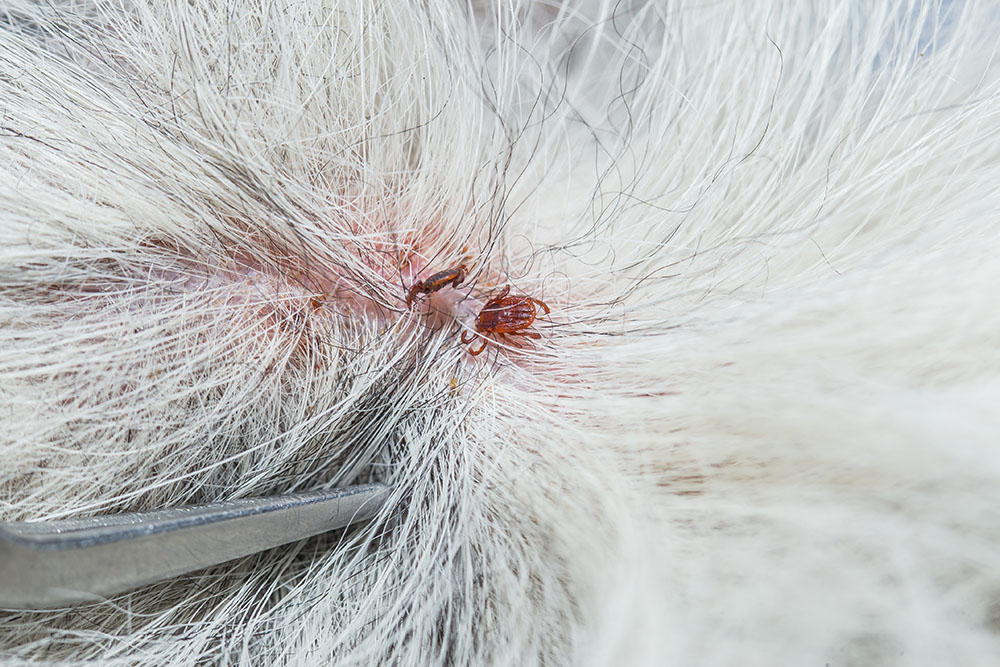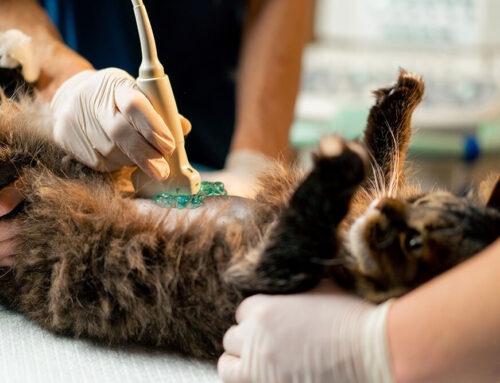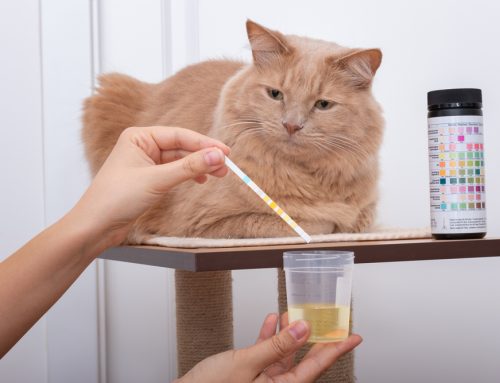Flea Allergies: Small Pests, Big Problems
Your dog is scratching nonstop, or your cat’s skin suddenly looks raw and inflamed. Is it allergies- or fleas?! Even just one flea bite can trigger flea allergy dermatitis, a condition that causes intense itching, scabbing, and secondary infections. Left untreated, it only worsens with time.
At Midtown Veterinary Hospital in Rochester, NY, our AAHA-accredited clinic combines personalized prevention plans and advanced dermatology services to help pets stay comfortable and healthy.
Recognizing and Treating Flea Allergy Dermatitis
Flea allergy dermatitis (FAD) is one of the most common skin conditions in dogs and cats. Unlike a simple flea infestation, it occurs when pets develop an allergic reaction to proteins in flea saliva. Even a single bite can trigger intense itchiness.
Beyond typical scratching, affected pets often have relentless itchiness that leads to excessive biting and licking. This can cause open wounds, scabs, hair loss, and, without treatment, secondary bacterial infections, and early detection helps prevent complications. Irritation commonly starts around the base of the tail, lower back, and hindquarters where fleas congregate.
Identifying Flea Allergy Dermatitis in Pets
Common Signs and Symptoms of FAD in Pets
Symptoms are often disproportionate to the number of fleas you see. Many owners observe significant skin damage without finding many fleas because allergic pets groom so vigorously that they remove them. Affected pets may scratch until they bleed, lose sleep, and act distressed.
Patterns of hair loss and inflammation typically appear around the tail base, lower back, inner thighs, and sometimes the belly. Dogs may develop hot spots, which are moist, infected patches of skin.
Cats frequently develop miliary dermatitis, which appears as small, crusty bumps across the skin. Young pets, seniors, and those with other allergies are at higher risk.
When to Visit the Vet for FAD
See your veterinarian if home care isn’t helping or symptoms worsen despite prevention efforts. Many conditions mimic flea allergy dermatitis, so accurate diagnosis matters.
Midtown Veterinary Hospital’s diagnostic services help confirm flea allergy dermatitis and rule out food allergies, environmental allergies, or bacterial infections so your pet gets targeted treatment. Seek prompt care if you notice signs of infection such as odor, pus, warmth, or significant pain, as antibiotics may be required.
Prevention Strategies for FAD in Pets
Year-Round Parasite Prevention for Pets is Essential
Prevention is the cornerstone of managing flea allergies. Continuous, year-round flea protection can help stop infestations before they start. Modern preventives kill fleas before they bite, reducing allergic flare-ups, but only if used consistently. Rochester’s warm summers and the ability of fleas to survive indoors year-round make continuous prevention for every pet in the home- even indoor pets- critically important.
Grooming and Hygiene for Pets
Routine grooming makes it easier to detect fleas, flea dirt, or irritated skin before problems escalate. Do the following at home to spot flea issues early:
- Use a fine-toothed flea comb weekly to check for flea dirt (black specks that turn reddish-brown when moistened) or adult fleas.
- Bathe with gentle, hypoallergenic shampoos for temporary relief; ask your vet about frequency to avoid drying the skin.
Creating a Flea-Free Environment for Your Pet at Home
Environmental control is key. Adult fleas spend most of their time in carpets, upholstery, and bedding and not on your pet. Once you have fleas in your home, it can take months of dedicated work to break the life cycle.
- Vacuum carpets, furniture, and corners frequently; dispose of contents immediately.
- Wash pet bedding in hot water weekly. Choose washable covers and blankets for easy cleaning.
Treatment Options for FAD in Pets
Veterinary Treatments for Your Pet
Managing flea allergy dermatitis goes beyond killing fleas. Midtown Veterinary Hospital’s wellness and prevention services include comprehensive, personalized plans.
Treatment usually combines:
- Immediate relief to control itching and protect skin
- Long-term flea prevention
- Support for skin and immune health
- Allergy evaluation when other triggers are suspected
Severe cases may need prescription medications and treatment for secondary infections, all monitored by your veterinarian for safety and effectiveness.
Medications and Topical Treatments for FAD in Pets
Common therapies include antihistamines, corticosteroids, and newer immunomodulators tailored to your pet’s age, health, and symptom severity. Topical shampoos, sprays, and ointments soothe irritated skin and support healing; some also repel fleas. If secondary bacterial infections develop, antibiotics may be necessary for several weeks, which is another reason prevention is preferable.
Integrative Support to Complement Care for Your Pet
Some owners add omega-3 fatty acids for skin health, probiotics for immune support, and environmental tweaks to reduce overall allergens. These work best alongside proven preventives and veterinary-guided treatment. Always discuss supplements or alternative options with your veterinarian.
The Role of Ongoing Veterinary Care for Pets’ Overall Health
Building a Relationship with Your Vet
Success requires teamwork. Regular check-ups let your veterinarian monitor progress, adjust treatments, and prevent setbacks. Midtown Veterinary Hospital values open communication. When you share notes about flare-up patterns, seasons, or new symptoms, this helps our team fine-tune care. This is especially important for pets with chronic allergies whose needs change with age, season, or other health factors.
Monitoring and Adjusting Treatment Plans for Your Pet
Plans should evolve with your pet. Track scratching frequency, skin changes, and overall comfort. Your vet can then determine whether current strategies are working or need adjustment. In Rochester, many pets benefit from seasonal tweaks to prevention and therapy.
Flea Allergy Facts Pet Owners Often Get Wrong
Clearing Up Common Beliefs about Fleas and Pets
- “Indoor pets can’t get fleas.” Fleas hitchhike on clothing, other pets, or through open doors, so indoor-only pets can still develop flea allergies.
- “You must see fleas to diagnose a flea allergy.” Allergic pets often groom so thoroughly that they remove most fleas; the allergic reaction may be the only clue. Fleas are just one allergy trigger, and a full workup may reveal additional allergens that also need management.
FAQs from Pet Owners About FAD
- Can flea allergy dermatitis be cured? There’s no permanent cure, but consistent prevention and medical care allow most pets to live comfortably.
- How long until symptoms improve? Mild cases often improve in days to weeks; severe cases with infections may take several weeks to months.
- Is it contagious to other pets? The allergy isn’t contagious, but fleas spread easily. All pets in the home need prevention.
- Can humans get flea allergy dermatitis? People can react to flea bites, but the condition in pets differs from human reactions.
Taking Control of Your Pet’s Comfort
Flea allergy dermatitis turns tiny pests into major health challenges, but with the right plan and professional support, you can keep your pet comfortable. If you notice excessive scratching, hair loss around the tail and lower back, or signs of infection like odor or discharge, prompt veterinary care can prevent complications.
Midtown Veterinary Hospital provides comprehensive diagnostic services and personalized treatment plans for accurate diagnosis and effective, long-term management. Call (585) 546-1550 to schedule an appointment and give your pet the relief they deserve.







Leave A Comment